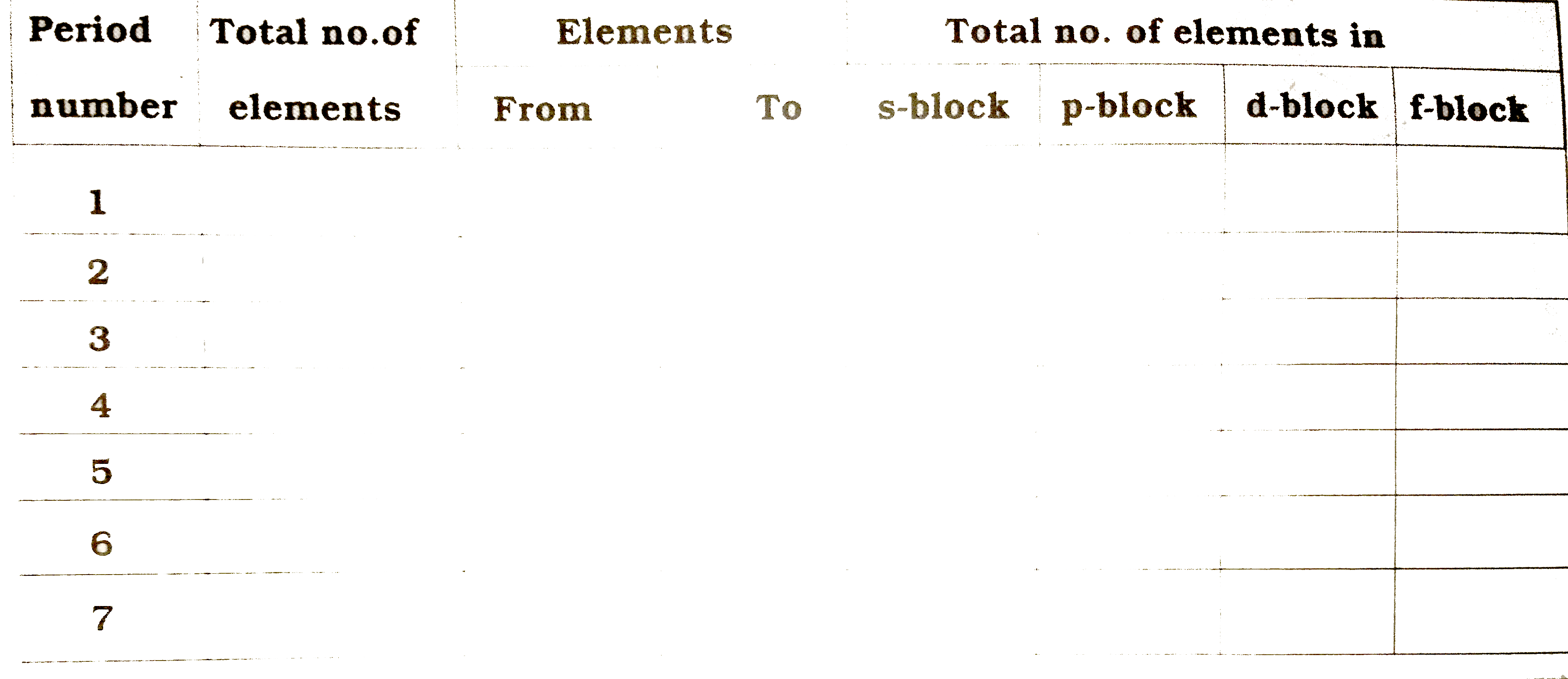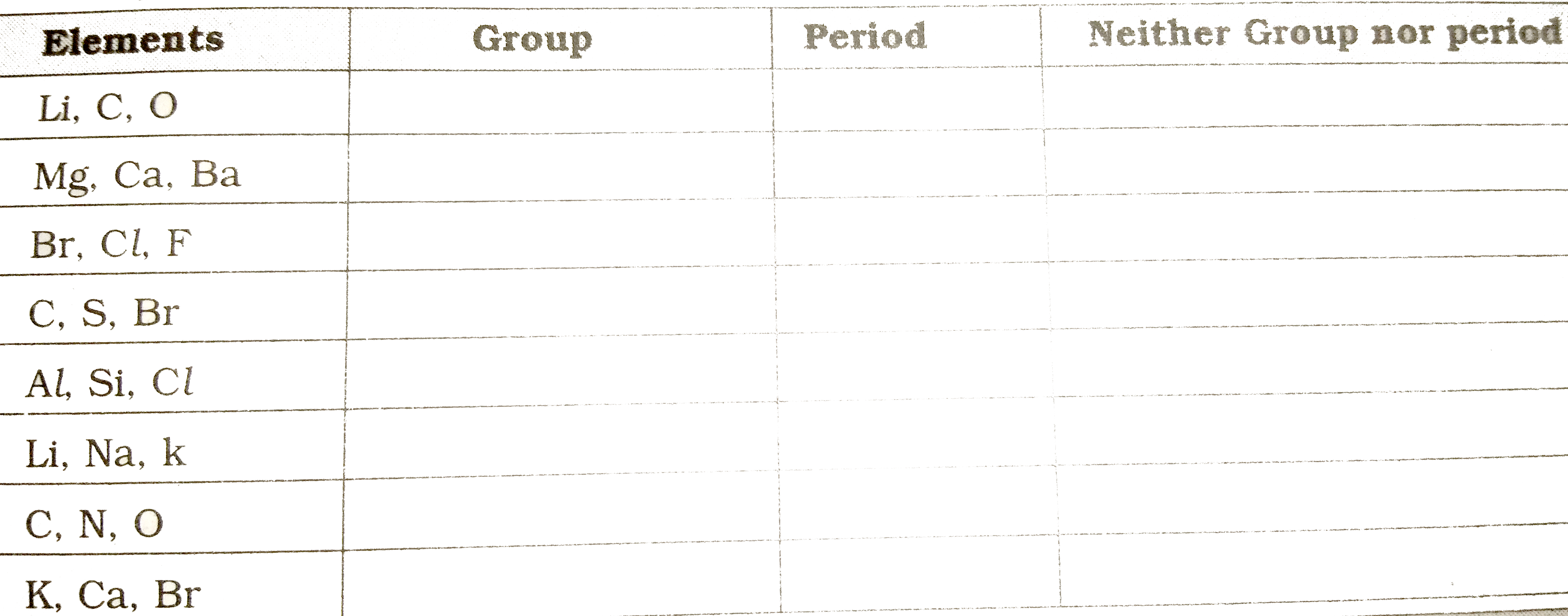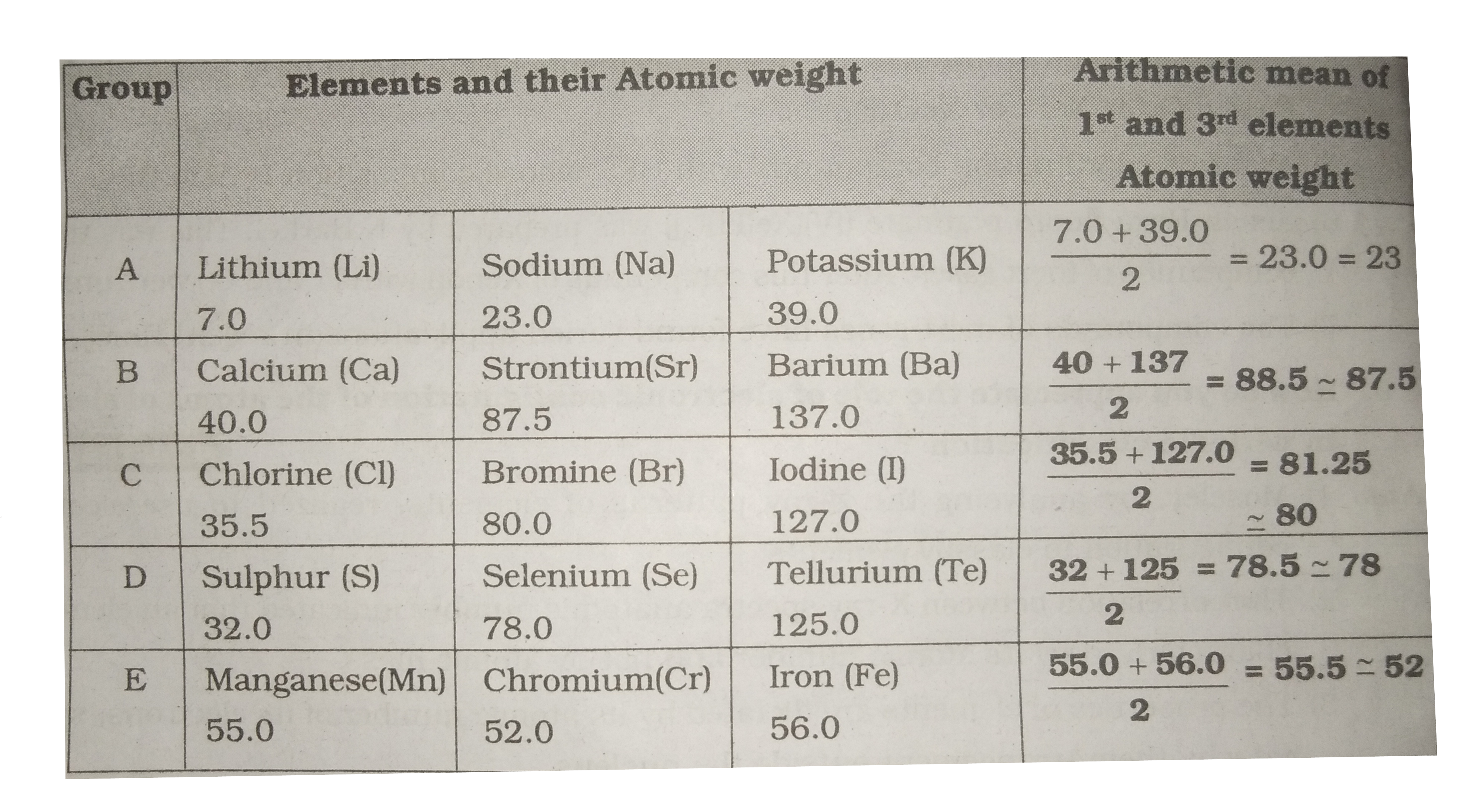Complete Solutions to EXERCISE of chapter CLASSIFICATION OF ELEMENTS-THE PERIODIC TABLES of Class 10 book with complete answers and questions
| Class 10 | CHEMISTRY |
| Chapter | CLASSIFICATION OF ELEMENTS-THE PERIODIC TABLES |
| VGS PUBLICATION-BRILLIANT | EXERCISE |
| Number Of Questions | 100 |
| Academic Year | 2023-24 |
What are the limitations of Mendeleev’s periodic table ? How could the modern periodic table overcome the limitations of Mendeleev’s table?
06:24View SolutionDefine the mordern periodic law . Discuss the construction of the long form of the periodic table .
03:10View SolutionWhat are the essential features of the periodic table of Mendeleev? Discuss how his table has been modified subsequently.
07:12View SolutionExplain how the elements are classified into S. p .d and f- block elements in the periodic table and give the advantage of this kind of classification .
05:57View SolutionWrite down the characteristics of the element having atomic number 17.
 04:39View Solution
04:39View SolutionComplete the following table using the periodic table.
 06:49View Solution
06:49View SolutionComplete the following table using the periodic table .
 02:30View Solution
02:30View SolutionGiven below is the electronic configuration of elements A, B, C, D : (A)` 1s^2 2s^2, (B) 1s^2 2s^2 2p^6 3s^2,(C) 1s^2 2s^2 2p^6 3s^2 3p^3, (D) 1s^2 2s^2 2p^6` , Which are the elements coming within the same period?
02:34View SolutionGiven below is the electronic configuration of elements A,B,C,D: (A) `1s^2 2s^2,(B)1s^2 2s^2 2p^6 3s^2,(C)1s^2 2s^2 2p^6 3s^2 3p^3,(D)1s^2 2s^2 2p^6`, Which are the ones coming within the same group?
03:30View SolutionGiven below is the electronic configuration of elements A,B,C,D: `(A) 1s^2 2s^2, (B)1s^2 2s^2 2p^6 3s^2, (C) 1s^2 2s^2 2p^6 3s^2 3p^3, (D) 1s^2 2s^2 2p^6`, Which are the noble gas elements?
02:32View SolutionGiven below is the electronic configuration of elements A,B,C,D: `(A) 1s^2 2s^2, (B) 1s^2 2s^2 2p^6 3s^2, (C) 1s^2 2s^2 2p^6 3s^2 3p^3, (D) 1s^2 2s^2 2p^6`, To which group and period does the element 'C' belong?
03:55View Solution`1s^2 2s^2` is the electronic configuration of which element?
01:29View SolutionWhat is valency of `1s^2 2s^2 2p^6 3s^2` ?
01:08View SolutionWhich pair of elements belongs to the same group ? (atomic numbers are given)
02:44View SolutionTo which group and period does the element 'D' belong ?
02:51View SolutionS- block and p - block elements except 18 th group elements are sometimes called as 'Representative elements based on their abundant avilability in the nature . Is it justifed ? Why ?
02:31View SolutionThe electronic configuration of the elements, X, Y and Z are given below. A) X=2, B) Y=2,6, C) Z=2,8,3, Which element belongs to second group?
03:44View SolutionThe electronic configuration of the elements X , Y , and Z are given below .
a ) X=2 b ) Y= 2,6 c ) Z= 2,8 ,2
which element belongs to second period ?00:51View SolutionThe electronic configuration of the elements, X, Y and Z are given below. A) X=2, B) Y=2,6, C) Z=2,8,3, Which element belongs to second group?
03:44View SolutionState the number of valence electrons , the group number and the period number of each element given in the following table :
 12:03View Solution
12:03View SolutionState whether the following elements belong to a Group (G ) , Period (P) neither Group nor period (N ) .
 08:09View Solution
08:09View SolutionIdentify the element that has the larger atomic radius in each pair of the following and mark it with a symol .
(I ) Mg or Ca (ii ) Li or Cs (iii ) N or P (iv ) B or Al02:07View SolutionIdentify the elements that has the lower ionization energy in each pair of the following and mark it with a symol .
(i) Mg or Na (ii) Li or O (iii) Br or F (iv ) K or Br01:49View SolutionHow does metallic character change when we move
Down a group ?01:02View SolutionHow does metallic character change when we move
Down a group ?01:02View SolutionOn the basis of atomic numbers predict to which block the elements with atomic number 9 , 37 ,46 and 64 belongs to ?
01:53View SolutionUsing the periodic table , predict the formula of compound formed between element x group 13 and another element Y of group 16 .
01:42View SolutionAn element has atomic number 19. where would you expect this element in the periodic table and Why ?
02:53View SolutionHow do the positions of elements in the periodic table help you to predict its chemical properties ? Explain with and example .
02:40View SolutionIn period 2 element X is to the right of element Y . Then , find which of the element have :
Low nuclear charge00:59View SolutionIn period 2 element X is to the right of element Y . Then , find which of the element have :
Low atomic size01:10View SolutionIn period 2 element X is to the right of element Y . Then , find which of the element have :
High ionization energy01:03View SolutionIn period 2 element X is to the right of element Y . Then , find which of the element have :
High electronegativity01:05View SolutionIn period 2 element X is to the right of element Y . Then , find which of the element have :
More metallic character00:57View SolutionNumber of elements present in period - 2 of the long form periodic table _________
00:55View SolutionNitrogen (Z=7) is the element of group V of the periodic table. Which of the following is the atomic number of the next element in the group ?
01:31View SolutionElectonic configuration of an atom is 2,8,7, . To which of the following elements would would it be chemically similar ?
01:03View SolutionWhich of the following is the most active metal ?
02:29View SolutionAluminium does not react with water at room temperature but reacts with both dil . Hcl and NaOH solutions . Verify these statements experimentally . Write your observation with chemiscal equation , From these observations , can we concluds that Al is a metalloid ?
01:28View SolutionHow can you explain Aluminium (Al) is a metalloid with chemical equations ?
02:39View SolutionWhat relation about elements did dobereiner want to establish ?
02:29View SolutionThe densities of calcium (ca ) and barium (Ba ) are 1.55 and 3.51 g `cm ^(-3) ` respectively based on Dobereiner's law of triads , can you give the approximate density of strotium (Sr ) ?
02:08View SolutionAll akali metals are solids but hydrogen is a gas with diatomic molecules . Do you justify the inclusion of hydrogen in first group with alkali metals ?
02:04View SolutionIF lanthanides and actinides are inserted within the table . Imagine how the table would be ?
03:16View SolutionDo you know why Newlands proposed the law of octaves ? Explain your answer in terms of the modern structure of the atom .
02:46View SolutionWhy did Mendeleeff had to leave certain blank spaces in his periodic table ? What is your explanation for this ?
02:39View SolutionWhat is your understanding about `Ea _(2 ) O_(3 ) , EsO_(2) ` ?
01:27View SolutionSecond ionization energy of an element is higher than its first ionization energy Why ?
01:29View SolutionThe calculated electron gain enthaly values for alkaline earth metals and noble gases are positive . How can you explain this ?
02:40View SolutionDo you think Newland's law of octaves is correct ? Justify .
01:48View SolutionWhy are lanthanides and actinides placed separately at the bottom of the periodic table ?
01:08View SolutionThe second period element , for example , for example 'F' has less electron gain enthyalpy than the third period element of the same group of example'Cl' . Why ?
03:28View SolutionObserve the following table and Fill it .

Observations :
Can you establish the same relationship with the set of elements given in the remaining rows ?03:09View SolutionObserve the following table and Fill it .

Observations :
Find average atomic weights of the first and third elements in each row and compare it with the atomic weight of the middle element.08:14View SolutionWhat is atomic number ?
01:09View SolutionConsider the following elements of third period of modern periodic table :
`{:("Period III elements ",Na,Mg,Al,Si,P,S,Cl,Ne),("Atomic number ",11,12,13,14,15,16,17,18):}`
How does valency very in a period on going from left to right ?01:16View SolutionHow does the valency vary on going down a group ?
01:22View SolutionDO the atom of an element and its ion have same size ?
02:55View SolutionImagine , which one in each of the following pairs is large in size relatively with other ? Explain .
(X ) Na,Al01:25View SolutionImagine , which one in each of the following pairs is large in size relatively with other ? Explain .
(Y ) Na ,`Mg^(+2)`01:14View SolutionWhich one in each of the following pairs is larger in size? `S^(2-)`,`Cl^(-)`.
01:32View SolutionWhich one in each of the following pairs is larger in size ?
(a) `Na,Al " " (b ) Na,Mg^(+2)" "(C ) S^(2- ) , Cl^(-) " " (d ) Fe^(2+), Fe ^(3+)" " (e ) C^(4- ) , F^(-)`04:22View SolutionWhich one in each of the following pairs is larger in size? `C^(4-)`,`F^(-)`.
01:30View SolutionWhich one between Na and `Na^(+)` would have more size ?
01:08View SolutionWhich one between Cl and `Cl^(-) ` would have more size ? Why ?
01:49View SolutionA and B are two elements . The compound formed with A and B is `A_(2) ,B `. What are the valencies of A and B .
01:05View SolutionThe Atomic number of an element is 35 where would you expect the position of this element in the periodic table ? Why ?
02:00View SolutionWhy were Dobereiner , Newlands and Mendeleeff not 100 % successful in their classfication of elements ? Why is the modern table table relatively a better classification ? Predict the reason .
02:56View SolutionTwo elements X and Y belong to Groups 1 and 2 respectively in the same period of the periodic Table .Compare these elements with respect to :
Number of electrons in their outermost orbit .01:01View SolutionTwo elements X and Y belong to Groups 1 and 2 respectively in the same period of the periodic Table .Compare these elements with respect to :
Their atomic size and their valancies .02:34View SolutionTwo elements X and Y belong to Groups 1 and 2 respectively in the same period of the periodic Table .Compare these elements with respect to :
their ionisation energy and metallic character .01:40View SolutionTwo elements X and Y belong to Groups 1 and 2 respectively in the same period of the periodic Table .Compare these elements with respect to :
Formula of their chlorides and sulphates .01:42View SolutionExplain three factors which influence the electron affinity (Electron Gain Enthalpy)
10:55View SolutionHow are the elements arranged into groups and periods in the modern periodic Table ? Elements in a group posses similar properties , but elements in a period do not show similarites in their properties . Why ?
03:11View SolutionWrite the factors that influence ionization energy and Explain any three of them .
08:27View SolutionDefine ' element ' according ot boyle .
01:20View SolutionState law of triads .
01:44View SolutionWhat are the limitations of Dobereiner's law to triads ?
02:15View SolutionState the law of octaves .
01:45View Solutionwhat are the limitations for Newlands' law of octaves ?
03:40View SolutionState the periodic law proposed by mendeleeff.
01:12View SolutionWhat are the limitations of mendeleeff's periodic table ?
01:55View SolutionWhat is atomic number ?
01:09View SolutionWrite modern periodic law .
01:48View SolutionWhat is a group?
01:19View SolutionHow is a period formed?
01:34View SolutionWhich elements are called lanthanides ?
02:41View SolutionWhich elements are called actinides ?
01:09View SolutionHow the elements are callified as metals and non- metals based on their electronic configuration ?
02:23View SolutionWhat are metalloids ?
01:43View SolutionWhy do elements in the same group have similar physical and chemical properties?
02:43View SolutionWhy the elements in a period posses different chemical properties ?
02:33View SolutionDefine valaency .
01:15View SolutionDefine atomic radius.
02:05View SolutionWhat is crystal radius (or) metallic radius ?
02:52View SolutionWhat is covalent radius ?
02:33View SolutionHow does atomic radius vary in a period and in a group? How do you explain the variation?
03:57View SolutionDefine Ionization energy .
01:17View SolutionHow does the ionization energy vary in a group and a period ?
01:09View SolutionElectron affinity is
01:28View Solution
EXERCISE questions and complete solutions for chapter CLASSIFICATION OF ELEMENTS-THE PERIODIC TABLES of VGS BRILLIANT CHEMISTRY (TELUGU ENGLISH) of Class 10
